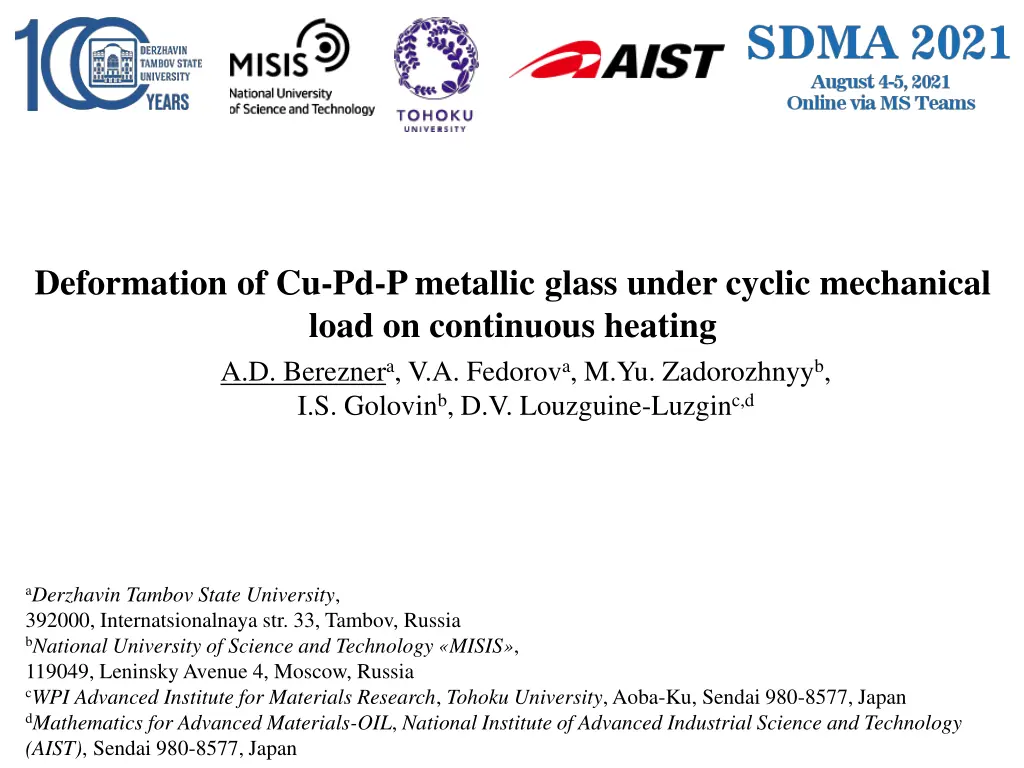
Deformation of Cu-Pd-P Metallic Glass Study
Explore the deformation behavior of Cu-Pd-P metallic glass under cyclic mechanical load during continuous heating. This research project involves modeling and experimenting with the plastic flow of a Co-based amorphous alloy subjected to dynamic loading conditions. Tasks include suggesting and verifying deformation model functions, varying loading frequency, deriving key relationships from Newton's laws of motion, and drawing conclusions. Materials, methods, results, and discussions are detailed. Experimental and analytical relations of specimen elongation with time and temperature are presented. Loading schemes and force equations are analyzed in the context of material behavior.
Download Presentation

Please find below an Image/Link to download the presentation.
The content on the website is provided AS IS for your information and personal use only. It may not be sold, licensed, or shared on other websites without obtaining consent from the author. If you encounter any issues during the download, it is possible that the publisher has removed the file from their server.
You are allowed to download the files provided on this website for personal or commercial use, subject to the condition that they are used lawfully. All files are the property of their respective owners.
The content on the website is provided AS IS for your information and personal use only. It may not be sold, licensed, or shared on other websites without obtaining consent from the author.
E N D
Presentation Transcript
Deformation of Cu-Pd-P metallic glass under cyclic mechanical load on continuous heating A.D. Bereznera, V.A. Fedorova, M.Yu. Zadorozhnyyb, I.S. Golovinb, D.V. Louzguine-Luzginc,d aDerzhavin Tambov State University, 392000, Internatsionalnaya str. 33, Tambov, Russia bNational University of Science and Technology MISIS , 119049, Leninsky Avenue 4, Moscow, Russia cWPI Advanced Institute for Materials Research, Tohoku University, Aoba-Ku, Sendai 980-8577, Japan dMathematics for Advanced Materials-OIL, National Institute of Advanced Industrial Science and Technology (AIST), Sendai 980-8577, Japan
The main goal is a model and experimental investigation of plastic flow of Co-based amorphous alloy on variable heating under dynamic (periodical) loading. The tasks: 1) Suggestion and verification of the model function for deformation; 2) Variation of the loading frequency at the same rate of heating; 3) Derivation of the main relationship in frames of Newton s laws of motion; 4) Further conclusions from the results; 2
Materials and Methods Samples: Cu54Pd28P18alloy of 30 mm (length), 2.5 mm (wide), 0.025 mm (thickness). Structure testing: Cu-K X-ray diffractometry. Temperature stability: DSC at 5 K/min., 528 K and 568 are glass-transition (Tg) and crystallization temperatures, respectively. Dynamic mechanical analysis (DMA): a specimen with 18.5 mm working zone, Q800 (TA Instruments), heating at 5 K/min., oscillation mode at 20 kPa amplitude and 0.3 Hz - 3 Hz frequencies. Preloading conditions are 20 MPa. Figure 1. General view of the working equipment (Q800 analyzer) 3
Results and Discussion Ct = + (1) ( ) l t l 0 2 B Bt l0 is initial length; and B are analytical fixed parameters having [m s] and [s] units, respectively. B parameter is time of the fracture of a specimen; t current deformation time and C is a deformational coefficient of material. T T = 0 t (2) V T T0 and T the initial and current temperatures of heating; VT the heating rate. Figure 2. Experimental and analytical relations of the elongation of a specimen as a function of time and temperature 4
(3) = sin( ) m x load F A t reaction F m is mass of the material point (the machine grip), acceleration of the material point, Fload constant external load from the testing machine, A amplitude of external additional (load) oscillations, angular frequency of oscillations (2 3 Hz equals to 6 rad/s), Freaction reaction force of the amorphous specimen (the spring). x Figure 3. Scheme of loading: Loading direction is indicated with the red arrow and the reaction force is depicted with the green arrow 2 B mC = = ( , ( )) sin( ) F t T F A t reaction load 3 ( ) t (4) 3 2 T T mCV + = 0 T sin( ) F A load 3 V ( ) BV T 6 B T T 0 T 2 2 B + x mC 2 m m = sin( ) F F A (5) F F F A x = reaction load 2 C B x B + x 2 reaction elastic load 3 B 3 ( ) B C B x 6 B m k (6) 2 5
a) Figure 4. a) The calculated relations of reaction force F(t)/F0 of the specimen: with the cyclic load the orange line and without it the black marker. b) An experimental graph , ( ) 0 Freaction 0.000023 = + = 1 . 0 0025 sin( 6 ) t 3 F ( 47 58 . ) t 0 b) 002875 . 0 1 . 0 0025 sin( 2 . 1 ( 303 )) T (7) 3 540 ( 9 . ) T = ( ) 0 Freaction 0.000023 002875 . 0 = = 1 1 3 3 F ( 47 58 . ) 540 ( 9 . ) t T 0 6
a) b) c) d) Figure 5. Reaction force relations for Co-based (a) and Al-based amorphous alloys (b,c,d) 7
Conclusions 1) Thermal activation and cyclic loading lead to faster deformation of the Cu-Pd-P metallic glassy specimens at a fixed frequency that can be described by a classical mechanical model. Herewith, the occurrence of the wave areas (nodes and antinodes), wherein elastic force is constant(regions of periodic stability), is predictable for the specimen. 2) Received relations can be used for further investigations not only for DMA but as a basement for comprehensive study in frames of different fields of physics. 8
